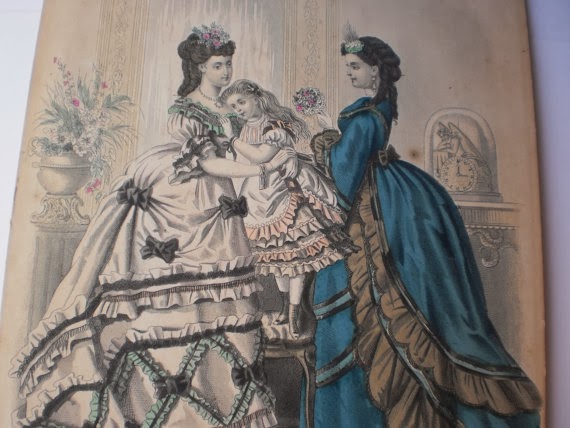Movements
in Home Décor and Fashion became particularly interesting during the
mid-19th century
Victorian era. With the onset of the industrial age, advanced
transportation, and growing ease of communication, fashion and décor
trade markets (such as those found in Paris, London, and New York)
experience a growing influence on world trends. For the first time in
history, new ideas – which reflected changes in social ideologies –
were able to be tested and marketed in a matter of months. Trends
that used to take hold for generations, now changed generationally,
and soon became identifiable by the decade, and then to the
ever-changing fickle “season.”
In this 5-part series, we will be exploring five major movements in home décor: The Victorian Era, The Edwardian Period, The Arts and Craft Period, The Depression Era, and the Modern Era. Generally speaking, with each new era we see a movement away from elaborate detailed romantic pieces to ones that are more organic, and streamline. These changes reflect broader social changes which move from values of stability, tradition, and durability to a more mobile, free, and “less-stuffy” outlook on life and living.
Part
One: Victorian Era
The
Victorian Era is marked by the reign of Queen Victoria of England
beginning in 1837 until her passing in 1901. Her reign is celebrated
as a time of peace and growth for England which has a great impact on
the world of art, music, architecture, home décor, and fashion.
Following the rational and sensible Georgian period, the Victorian
era is seen as one of romance, elaborate elegance, and refinement.
Victorian society valued tradition, durability, social status, and
entertainment. Families amassed estates with large collections to
pass down from one generation to the next as a sign of stability and
wealth. The traits of Victoria era décor are fanciness, rich colors,
durable materials, and elaborate details – each explored below:
FANCINESS
When
one thinks of the Victoria Era the word “Fancy” comes to mind.
Everything was fancy beyond reason. Fashions were both elaborate and
reserved. Men and women alike were clothed from top to bottom in
layer after layer including lacy cotton undergarment, embroidered top
clothing, wool hats, gloves, silk stockings, laced-up boots, and
buttoned overcoats. Variations continued throughout the period for
example - In the United States the Victorian influence is seen in the
Civil War fashion, in the late Victorian period we see the addition
of ladies bustles, and in France we see a bit more freedom and
romance in ladies’ hair styles. Victorian fashion motifs were
commonly seen on home décor and art items, such as this French
Fashion Print offered by Vintage
Carolina:
Likewise, home décor was fancy, fancy. Tables were set with elaborate china and specialized serving dishes, including such novelties as butter pats, individual salt bowls, celery dishes, and knife rests. This pair of crystal and silver knife rests is a prime example of Victorian extravagance. They may look like rare jewels, but they are design for the mundane task of keeping holding the blade of a used knife off the fine linens.
RICH
COLORS
The
color pallet was rich and inspired by the romance of nature. Colors
varied from deep reds, muted blues, fresh greens, and rosy pinks.
Multi-colored items with pretty details were signs of good tastes and
fashion: These Limoges
Orphan Teacups
offered by Nostalgic
Rose show the natural theme and
colors elevated by fine detailing and gold trim:
This
level of elegance was not reserved to the dining room. Here we see
the attention to detail, warm colors, and a floral motif in this
wonderful Vanity
Box offered by Wee
Lambie Vintage
DURABLE
MATERIALS:
Materials
popular in the Victorian era were equally regal and included carved
oak for furniture, heavy velvet for curtains, refined pottery for
vases, handmade lace for bedding, and a variety of embossed metals
for household items.
This set of ornate brass door knobs from Karen’s Chic and Shabby
This set of ornate brass door knobs from Karen’s Chic and Shabby
and the Gilt Frame offered by Lakeside Cottage show off the craftsmanship of the day:
Victorian elements continued to influence fashion and décor. In the 1980’s, for example, we find Victorian inspired lacy accents to blouses and skirts. Even today we find lace-up Victorian inspired boots on department store shelves. The Victorian period is unforgettable and has had an durable impacted on fashion, décor, art, and music.
Mary is the owner of the Etsy shop FineRomance








6 comments:
Mary, what a wonderful and informative installment. Look forward to the good read of next. Very very cool read!
Thank you, Dave. Lots of fun!
You're welcome Mary! Will you be touching base on Victorian fashion in relation to "steampunk"? Love to hear/read what you have to say!! Keep up the cool reads!
Thank you, Mary! This is fantastic. I learned a lot. :)
Gorgeous work and well researched. I love your illustrations too. ♥
Thank you Angela and Gail! Glad you liked it. Dave, thanks for the idea... I'm now thinking about doing an article at the end of this series to show how each of these fashion/décor trends have influenced modern...
Post a Comment